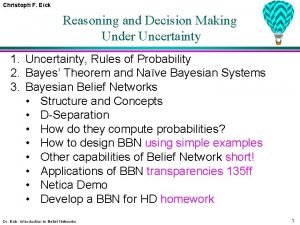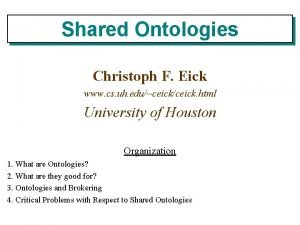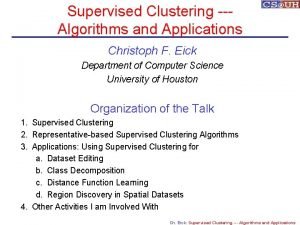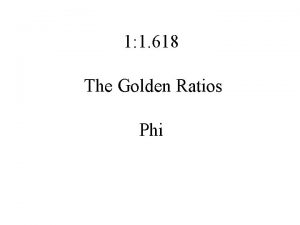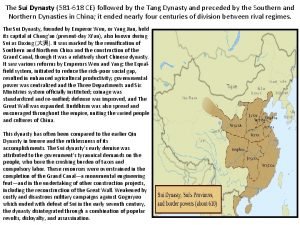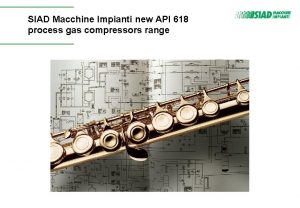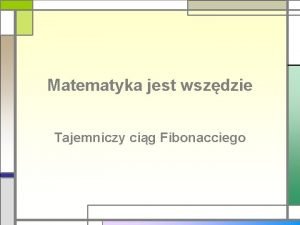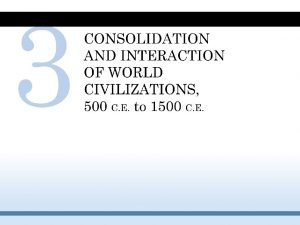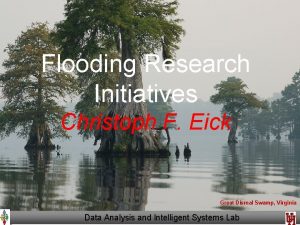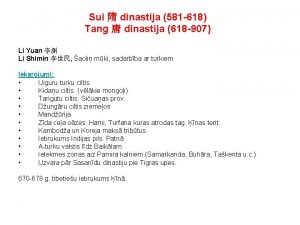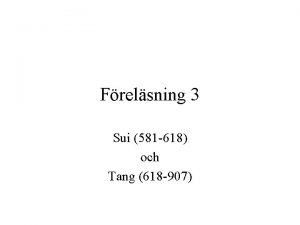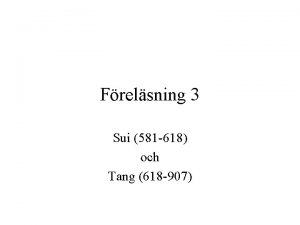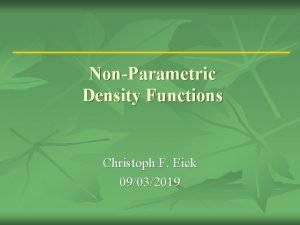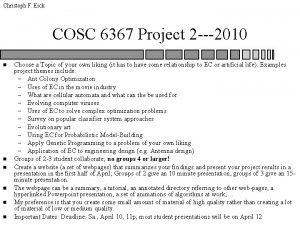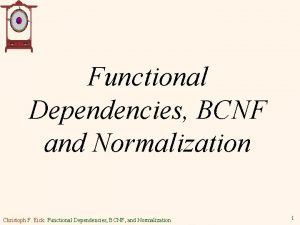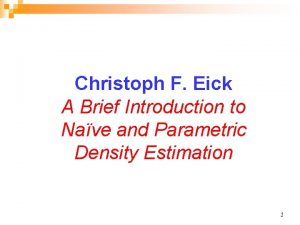Christoph F Eick 1 UHDAIS Research Projects 618














- Slides: 14

Christoph F. Eick 1

UH-DAIS Research Projects 6/18 -5/19 1. Flood Forecasting and Flood Risk Assessment 2. Understanding US Emotions in Time and Space 3. Spatial and Spatio-temporal Data Analysis Frameworks 4. St^2—Tools for Spatio-temporal Data Storytelling 5. Scalable Algorithms for Interestingness Hotspot Discovery 6. Educational Data Mining 7. Using AI for Route Planning 8. Disaster Informatics 9. Intelligent Crowdsourcing 2

Data Driven Flood Forecasting Frameworks 3

Polygon Analysis for Better Flood Risk Mapping Knowledge of Flooded Areas from Past Floods FEMA Flood Risk Zones DEM (Digital Elevation Maps) Find Correspondence Find Agreement, Combine, Validate, Evaluate Hand Value Multi-Contour Maps HEC-RAS Generated Polygons Austin Fire First Response Vehicle Flood Risk Map UH-DAIS Christoph F. Eick

Intelligent Crowdsourcing Motivation: Crowdsourcing has become quite popular: Ø Companies use it to create datasets for machine learning and to outsource tasks to the crowd. Ø Open. Street. Map and Waze are examples of crowdsourcing success stories. Research Goals: Ø Investigate AI Techniques to Enhance Crowdsourcing Ø Develop Intelligent Crowdsourcing Apps for Disaster Informatics Ø Investigate the psychological and social aspects of intelligent crowdsourcing

UH-DAIS Section 4: Christoph F. Eick Tweet Emotion Mapping: see other Slide Show Understanding US Emotions in Time and Space Related to: http: //worldhappiness. report/ed/2018/ & http: //hedonometer. org Inspired by: https: //www. ted. com/talks/hans_rosling_asia_s_rise_how_and_when Great Dismal Swamp, Virginia Data Analysis and Intelligent Systems Lab

K 2: Happiness and Opinion Mapping (from Tweets & …) I wanna sc ream, I wa nna shout as I’m not okay so much lf e s y m e t a Why do I h ow! w s e u l any va p m o c g Amazin start d o o G onday! M y p Hap Another lovely day e sick You make m We lost ourselves I hate you Everyday in every way my life gets better & better Emotion scores ❤ � I love you 7

K 2 Project Goals Given a set of tweets (or questionnaires soliciting preferences and opinions) with the location (longitude and latitude), time they were posted and their emotional assessment in [-1, +1] (+1: =very positive emotions, 0: =no or even mix of emotions, -1: very negative emotions) Research Steps and Goals: 1. Subdivide the dataset into batches, corresponding to different time intervals 2. Identify spatial clusters of highly positive emotions (e. g. average emotional assessment >0. 4) and regions of highly negative emotions (e. g. average emotion assessment < -0. 4) for each batch. 3. Capture patterns of change and evolution of the regions identified in 2. 4. Based on a selected story type and user preferences, convert results found in steps 2 and 3 into a narrative and animations that tells the story of spatiotemporal evolution of emotions in an region (e. g. Texas, US, …) over a period of time (e. g. 5 years, 1 year, 1 month), similar to: https: //www. ted. com/talks/hans_rosling_asia_s_rise_how_and_when

Educational Data Mining (EDM) UH-DMML

Fast Interestingness Hotspot Discovery • Objective: Objective Find interesting contiguous regions in spatial data sets based on the domain expert’s notion of interestingness which is captured in an interestingness function • Methodology: Methodology 1. Transform Dataset Into Graphs 2. Identify hotspot seeds 3. Grow seeds by adding neighboring objects 4. Remove redundant hotspots using a graph-based approach 5. Find Scope of hotspots (polygonal boundary detection) • Data sets: sets Gridded, polygonal, pointbased data sets

Helping Scientists to Make Sense Out of their Data Figure 1: Co-location regions involving deep and shallow ice on Mars Figure 2: Interestingness hotspots where both income and CTR are high. Figure 3: Maryland Crime Hotspots UH-DAIS

Recent Contributors to UH-DAIS Research Ph. D Students: Yongli Zhang, Romita Banerjee, Chong Wang and Karima Elgarroussi. Master Students: Yue Cao, Anusha Nemilidinne, Anjana Kumari, Priyal Kulkarni, Qian Qiu, Arjun SV and Akhil Talari. Undergraduate Students: Deniz Burduroglu, Duong Nguyen, Victor Zeng, Yilei Tian, Pallovi Romero, Israel Perez, Jackson Murrell Visiting/Exchange Students: Khadija Khaldi Contributing Alumni: Sujing Wang and Paul Amalaman. UH-DAIS

Some UH-DAIS Graduates 1 Dr. Wei Ding, Associate Professor, Department of Computer Science, University of Massachusetts, Boston Sharon M. Tuttle, Professor, Department of Computer Science, Humboldt State University, Arcata, California Christopher T. Ryu, Professor, Department of Computer Science, California State University, Fullerton Sujing Wang, Assistant Professor, Department of Computer Science, Lamar University, Beaumont, Texas Christoph F. Eick

Some UH-DAIS Graduates 2 Chun-sheng Chen, Ph. D Amazon Chong Wang, MS Apple Justin Thomas MS Section Supervisor at Johns Hopkins University Applied Physics Laboratory Mei-kang Wu MS Microsoft, Bellevue, Washington Jing Wang MS AOL, California Rachsuda Jiamthapthaksin Ph. D Faculty, Assumption University, Bangkok, Thailand Christoph F. Eick
